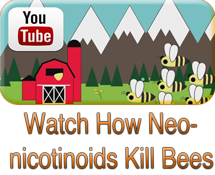29 January 2014 New independent study showing imidacloprid harm on bumblebees
A new scientific publication by Feltham et al. has shown new proofs of harm by imidacloprid (top 1 selling neonicotinoid insecticide worldwide) to bumblebee colonies at field realistic doses. Intoxicated bumblebees harvest significantly less pollen. Pollen is essential to the reproduction of bumblebees which are vital for the pollination services they provide. Those cannot be replaced by honey bees as they are complementary.
Abstract
Bumblebees and other pollinators provide a vital ecosystem service for the agricultural sector. Recent studies however have suggested that exposure to systemic neonicotinoid insecticides in flowering crops has sub-lethal effects on the bumblebee workforce, and hence in reducing queen production. The mechanism behind reduced nest performance, however, remains unclear. Here we use Radio Frequency Identification (RFID) technology to test whether exposure to a low, field realistic dose (0.7 ppb in sugar water and 6 ppb in pollen) of the neonicotinoid imidacloprid, reduces worker foraging efficiency. Whilst the nectar foraging efficiency of bees treated with imidacloprid was not significantly different than that of control bees, treated bees brought back pollen less often than control bees (40 % of trips vs 63 % trips, respectively) and, where pollen was collected, treated bees brought back 31 % less pollen per hour than controls. This study demonstrates that field-realistic doses of these pesticides substantially impacts on foraging ability of bumblebee workers when collecting pollen, and we suggest that this provides a causal mechanism behind reduced queen production in imidacloprid exposed colonies.

